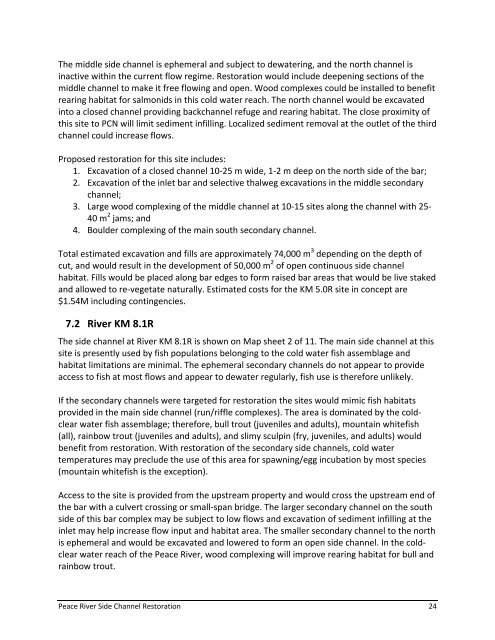GMSWORKS-3 Peace River Side Channel Restoration - BC Hydro
GMSWORKS-3 Peace River Side Channel Restoration - BC Hydro
GMSWORKS-3 Peace River Side Channel Restoration - BC Hydro
Create successful ePaper yourself
Turn your PDF publications into a flip-book with our unique Google optimized e-Paper software.
The middle side channel is ephemeral and subject to dewatering, and the north channel is<br />
inactive within the current flow regime. <strong>Restoration</strong> would include deepening sections of the<br />
middle channel to make it free flowing and open. Wood complexes could be installed to benefit<br />
rearing habitat for salmonids in this cold water reach. The north channel would be excavated<br />
into a closed channel providing backchannel refuge and rearing habitat. The close proximity of<br />
this site to PCN will limit sediment infilling. Localized sediment removal at the outlet of the third<br />
channel could increase flows.<br />
Proposed restoration for this site includes:<br />
1. Excavation of a closed channel 10‐25 m wide, 1‐2 m deep on the north side of the bar;<br />
2. Excavation of the inlet bar and selective thalweg excavations in the middle secondary<br />
channel;<br />
3. Large wood complexing of the middle channel at 10‐15 sites along the channel with 25‐<br />
40 m 2 jams; and<br />
4. Boulder complexing of the main south secondary channel.<br />
Total estimated excavation and fills are approximately 74,000 m 3 depending on the depth of<br />
cut, and would result in the development of 50,000 m 2 of open continuous side channel<br />
habitat. Fills would be placed along bar edges to form raised bar areas that would be live staked<br />
and allowed to re‐vegetate naturally. Estimated costs for the KM 5.0R site in concept are<br />
$1.54M including contingencies.<br />
7.2 <strong>River</strong> KM 8.1R<br />
The side channel at <strong>River</strong> KM 8.1R is shown on Map sheet 2 of 11. The main side channel at this<br />
site is presently used by fish populations belonging to the cold water fish assemblage and<br />
habitat limitations are minimal. The ephemeral secondary channels do not appear to provide<br />
access to fish at most flows and appear to dewater regularly, fish use is therefore unlikely.<br />
If the secondary channels were targeted for restoration the sites would mimic fish habitats<br />
provided in the main side channel (run/riffle complexes). The area is dominated by the cold‐<br />
clear water fish assemblage; therefore, bull trout (juveniles and adults), mountain whitefish<br />
(all), rainbow trout (juveniles and adults), and slimy sculpin (fry, juveniles, and adults) would<br />
benefit from restoration. With restoration of the secondary side channels, cold water<br />
temperatures may preclude the use of this area for spawning/egg incubation by most species<br />
(mountain whitefish is the exception).<br />
Access to the site is provided from the upstream property and would cross the upstream end of<br />
the bar with a culvert crossing or small‐span bridge. The larger secondary channel on the south<br />
side of this bar complex may be subject to low flows and excavation of sediment infilling at the<br />
inlet may help increase flow input and habitat area. The smaller secondary channel to the north<br />
is ephemeral and would be excavated and lowered to form an open side channel. In the cold‐<br />
clear water reach of the <strong>Peace</strong> <strong>River</strong>, wood complexing will improve rearing habitat for bull and<br />
rainbow trout.<br />
<strong>Peace</strong> <strong>River</strong> <strong>Side</strong> <strong>Channel</strong> <strong>Restoration</strong> 24

















